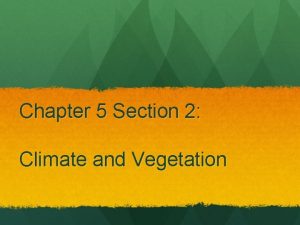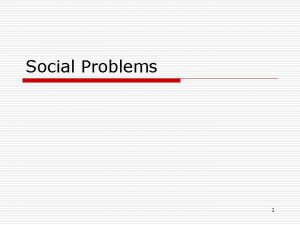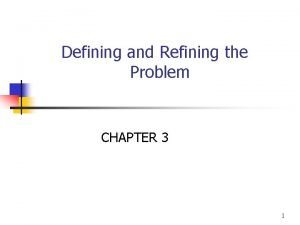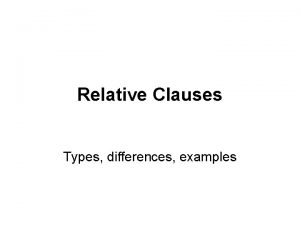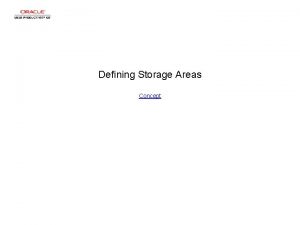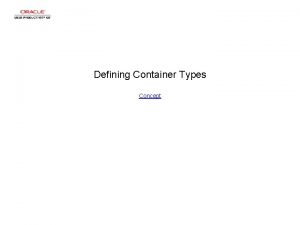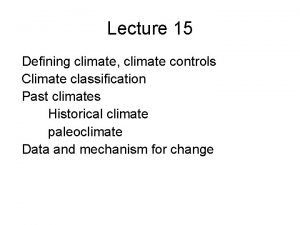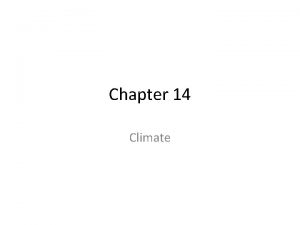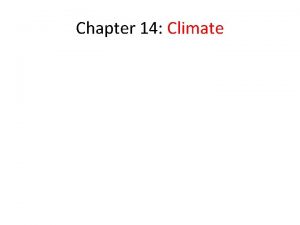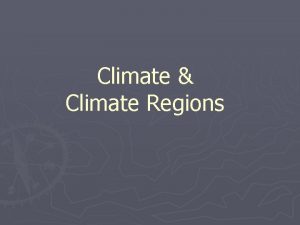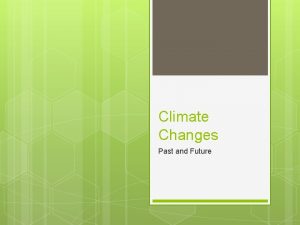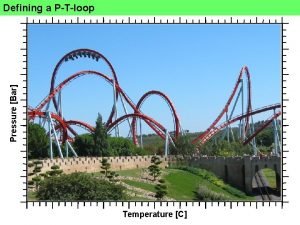Section 14 1 Defining Climate Section 14 1









































- Slides: 41

Section 14. 1 Defining Climate

Section 14. 1 Defining Climate Annual Averages and Variations Climatology is the study of Earth’s climate and the factors that affect past, present, and future climatic changes. Climate describes the long-term weather patterns of an area.

Section 14. 1 Defining Climate Annual Averages and Variations Normals The data used to describe an area’s climate include daily high and low temperatures, amounts of rainfall, wind speed and direction, humidity, and air pressure. The data are averaged on a monthly or annual basis for a period of at least 30 years to determine the normals, which are the standard values for a location.

Section 14. 1 Defining Climate Annual Averages and Variations Normals apply only to the specific place where the meteorological data were collected. Changes in elevation and other factors, such as proximity to large bodies of water, can cause climates to vary.

Section 14. 1 Defining Climate Causes of Climate Latitude has a great effect on climate. The amount of solar radiation received on Earth decreases from the equator to the poles.

Section 14. 1 Defining Climate Causes of Climate Latitude The area between 23. 5° S and 23. 5° N of the equator is known as the tropics. Tropical areas receive the most solar radiation and are generally warm year-round.

Section 14. 1 Defining Climate Causes of Climate Latitude The temperate zones lie between 23. 5° and 66. 5° north and south of the equator. As their name implies, temperatures in these regions are moderate.

Section 14. 1 Defining Climate Causes of Climate Latitude The polar zones are located from 66. 5° north and south of the equator to the poles. Polar temperatures tend to be cold.

Section 14. 1 Defining Climate Causes of Climate Topographic effects Water heats up and cools down more slowly than land. Thus, large bodies of water affect the climates of coastal areas. Temperatures in the lower atmosphere generally decrease with altitude. Thus, mountain climates are usually cooler than those at sea level.

Section 14. 1 Defining Climate Causes of Climate Topographic effects Orographic lifting leads to rain on the windward side of a mountain. The leeward side is usually dry and warm.

Section 14. 1 Defining Climate Causes of Climate Air masses affect regional climates by transporting the temperature and humidity of their source regions.

Section 14. 2 Climate Classification Climates are categorized according to the average temperatures and precipitation amounts.

Section 14. 2 Climate Classification Köppen Classification System The Köppen classification system is a classification system for climates that is based on the average monthly values of temperature and precipitation. Developed by German climatologist Wladimir Köppen, the system also takes into account the distinct vegetation found in different climates.

Section 14. 2 Climate Classification Köppen Classification System These graphs show temperature and precipitation for two different climates—a desert in Reno, Nevada, and a tropical rain forest in New Guinea.

Section 14. 2 Climate Classification Visualizing Worldwide Climates Köppen’s classification system is made up of five main divisions based on temperature and precipitation. Climate Types 1. Tropical a) Tropical Wet b) Tropical Wet & Dry 2. Mild a) Marine West Coast b) Mediterranean c) Humid Subtropical 3. Dry a) Semiarid b) Arid 4. Continental a) Warm Summer b) Cool Summer c) Subarctic 5. Polar a) Tundra b) Icecap 6. High Elevation a) Highlands b) Uplands

Section 14. 2 Climate Classification Microclimates A localized climate that differs from the main regional climate is called a microclimate.

Section 14. 2 Climate Classification Microclimates Heat islands Many concrete buildings and large expanses of asphalt can create a heat island, where the climate is warmer than in surrounding rural areas.

Section 14. 3 Climatic Changes Earth’s climate is constantly changing on many different timescales.

Section 14. 3 Climatic Changes Long-Term Climatic Changes Ice ages During the periods of extensive glacial coverage called ice ages, average global temperatures decreased by an estimated 5°C.

Section 14. 3 Climatic Changes Long-Term Climatic Changes Ice ages The most recent ice age, as shown here by the extent of its glaciers, ended only about 10, 000 years ago.

Section 14. 3 Climatic Changes Short-Term Climatic Changes While an ice age may last for several million years, other climatic changes occur over much shorter time periods. Seasons are short-term periods of climatic change caused by regular variations in daylight, temperature, and weather patterns.

Section 14. 3 Climatic Changes Short-Term Climatic Changes Seasons The variations that occur with seasons are the result of changes in the amount of solar radiation an area receives.

Section 14. 3 Climatic Changes Short-Term Climatic Changes Seasons When the north pole is pointed away from the Sun, the northern hemisphere experiences winter and the southern hemisphere experiences summer. During spring and fall, neither pole points toward the sun.

Section 14. 3 Climatic Changes Short-Term Climatic Changes El Niño Other short-term climatic changes include those caused by El Niño, a warm ocean current that occasionally develops off the western coast of South America.

Section 14. 3 Climatic Changes Short-Term Climatic Changes El Niño Under normal conditions, trade winds and ocean currents move warm water west across the Pacific Ocean.

Section 14. 3 Climatic Changes Short-Term Climatic Changes El Niño During El Niño, warm water surges back toward South America, changing weather patterns.

Section 14. 3 Climatic Changes Natural Causes of Climatic Changes Solar activity The Maunder minimum is the term used to describe the period of low numbers of sunspots. This period closely corresponds to an unusually cold climatic episode called the Little Ice Age.

Section 14. 3 Climatic Changes Natural Causes of Climatic Changes Solar activity Studies indicate that increased solar activity coincides with warmer-than-normal sea surface temperatures, while periods of low solar activity, such as the Maunder minimum, coincide with colder sea surface temperatures.

Section 14. 3 Climatic Changes Natural Causes of Climatic Changes Earth’s orbit Climatic changes might also be triggered by changes in Earth’s axis and orbit. The shape of Earth’s elliptical orbit appears to change, becoming more elliptical, then more circular, over the course of a 100, 000 -year cycle.

Section 14. 3 Climatic Changes Natural Causes of Climatic Changes Earth’s orbit Scientists hypothesize that a more elliptical orbit around the Sun could produce significant changes in Earth’s climate.

Section 14. 3 Climatic Changes Natural Causes of Climatic Changes Earth’s tilt At present, the angle of the tilt of Earth’s axis is 23. 5°. However, the angle of tilt varies from a minimum of 22. 1° to a maximum of 24. 5° every 41, 000 years. Scientists theorize that these changes in angle affect the differences in seasons.

Section 14. 3 Climatic Changes Natural Causes of Climatic Changes Earth’s tilt If the angle of the tilt of Earth’s axis decreased, there would be less temperature contrast between summer and winter.

Section 14. 3 Climatic Changes Natural Causes of Climatic Changes Earth’s wobble Over a period of about 26, 000 years, Earth wobbles as it spins around on its axis. Currently, the axis points toward the North Star, Polaris.

Section 14. 3 Climatic Changes Natural Causes of Climatic Changes Earth’s wobble determines the timing of the seasons. When the axis points toward the star Vega in 13, 000 years, the northern hemisphere will experience summer during the time now associated with winter.

Section 14. 3 Climatic Changes Natural Causes of Climatic Changes Volcanic activity Climatic changes can also be triggered by the immense quantities of dust-sized particles, called aerosols, that are released into the atmosphere during major volcanic eruptions.

Section 14. 3 Climatic Changes Natural Causes of Climatic Changes Volcanic activity Volcanic dust can remain suspended in the atmosphere for several years, blocking incoming solar radiation and thus lowering global temperatures.

Section 14. 4 Impact of Human Activities Influence on the Atmosphere The greenhouse effect The process of absorption and radiation of energy in the atmosphere results in the greenhouse effect—the natural heating of Earth’s surface caused by certain atmospheric gases called greenhouse gases.

Section 14. 4 Impact of Human Activities Influence on the Atmosphere The greenhouse effect An increase in the amount of atmospheric greenhouse gases, particularly carbon dioxide and methane, would theoretically result in increased absorption of energy in the atmosphere. This can lead to a rise in global temperatures, known as global warming.

Section 14. 4 Impact of Human Activities Global Warming Temperatures worldwide have shown an upward trend over the past 200 years, with several of the warmest years on record having occurred within the last two decades.

Section 14. 4 Impact of Human Activities Global Warming Burning fossil fuels One of the main sources of atmospheric carbon dioxide from humans is from the burning of fossil fuels including coal, oil, and natural gas. Burning fossil fuels also releases other greenhouse gases, such as methane and nitrous oxide, into the atmosphere.

Section 14. 4 Impact of Human Activities Global Warming Deforestation—the mass removal of trees— also plays a role in increasing levels of atmospheric carbon dioxide. When trees are cut down, photosynthesis is reduced, and more carbon dioxide remains in the atmosphere.
 What is defining and non defining clause
What is defining and non defining clause Relative clauses defining and non defining
Relative clauses defining and non defining Defining and non-defining
Defining and non-defining Defining relative clause meaning in telugu
Defining relative clause meaning in telugu Pronounlar
Pronounlar Nonessential adjective clause
Nonessential adjective clause Climate change 2014 mitigation of climate change
Climate change 2014 mitigation of climate change The structure of the atom section 2 defining the atom
The structure of the atom section 2 defining the atom Chapter 21 section 2 climate and vegetation
Chapter 21 section 2 climate and vegetation Why is the middle east so dry
Why is the middle east so dry Chapter 13 atmosphere and climate change section 1
Chapter 13 atmosphere and climate change section 1 Intelligence vs intelligent
Intelligence vs intelligent The defining moment in greek history is the wars.
The defining moment in greek history is the wars. What are the 4 characteristics of chordates?
What are the 4 characteristics of chordates? Social problem definition
Social problem definition Romeo and juliet act 4 summary
Romeo and juliet act 4 summary Lady montague defining quotes
Lady montague defining quotes Non-defining relative clauses as sentence modifiers
Non-defining relative clauses as sentence modifiers Defining poverty
Defining poverty Program block and control section
Program block and control section Lesson 15.1 defining and evaluating a logarithmic function
Lesson 15.1 defining and evaluating a logarithmic function Leadership and management definition
Leadership and management definition Problem identification research
Problem identification research Defining the problem and research objectives
Defining the problem and research objectives Non defining relatives clauses
Non defining relatives clauses Approaches to measuring performance
Approaches to measuring performance Defining marketing for the 21st century
Defining marketing for the 21st century Exploratory research question examples
Exploratory research question examples Nesting of member function
Nesting of member function Approaches to measuring performance
Approaches to measuring performance Abell's framework for defining the business
Abell's framework for defining the business New marketing realities
New marketing realities All stoichiometric calculations begin with a
All stoichiometric calculations begin with a Defining stoichiometry worksheet answers
Defining stoichiometry worksheet answers Oraciones con that relative clauses
Oraciones con that relative clauses Defining sentence example
Defining sentence example Zero relative clause
Zero relative clause Relative clause examples
Relative clause examples Aplusphysics kinematics-free fall answers
Aplusphysics kinematics-free fall answers Defining a project
Defining a project Defining fitness
Defining fitness Different approach of probability
Different approach of probability








